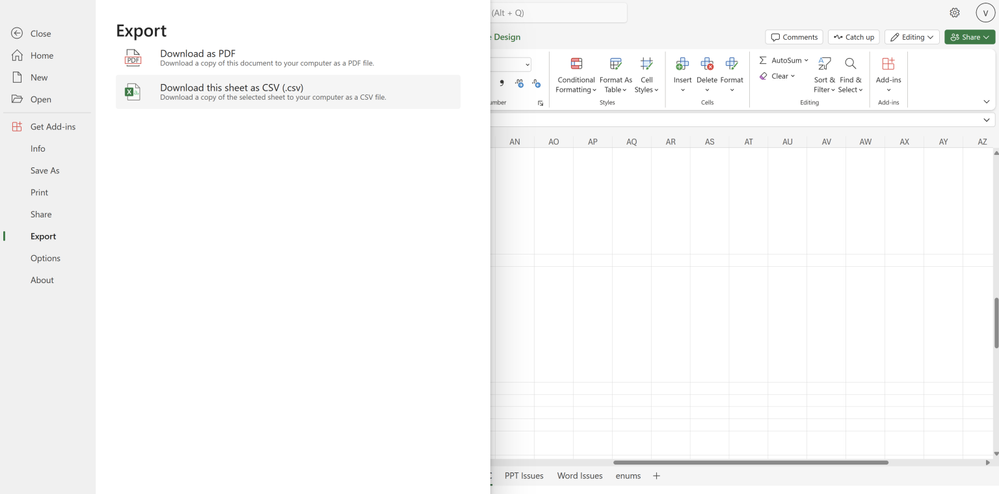
by Contributed | Mar 26, 2024 | Technology
This article is contributed. See the original author and article here.
Welcome to our March 2024 update.
This month, export to CSV and show details in PivotTables are now available in Excel for the web. Also, creating Power BI-connected tables is available in Excel for Windows users, and Office Scripts for Office 365 E1 and F3 licenses.
Excel for Web:
- Export to CSV
- Show Details in PivotTables #FIA
Excel for Windows:
- Create Power BI Connected Tables in Excel
- Office Scripts for Office 365 E1 and F3 Licenses
Excel for Web
1. Export to CSV
The ability to export to CSV is now available to all Web users. This experience was already supported for Windows, and Mac users and we’ve now expanded this service to all Web users. Take advantage of this lightweight file format in Excel for the Web to exchange and use data between apps and across platforms. Read more here >
 Export to CSV
Export to CSV
2. Show Details in PivotTables
We’ve added a new button on the ribbon under the ‘PivotTable Analyze’ tab called Show Details, this button allows you to drill into your PivotTables. Previously, you were able to double-click a value cell in the PivotTable and create a new table to further analyze the details for that value. This button makes this existing capability easier to find and use. This functionality was already available for Web users.
Excel for Windows
1. Create Power BI Connected Tables in Excel
A new Insert Table option is now available for the Power BI Datasets pane in Excel. It enables users to create a connected table directly in Excel. This streamlines the workflow of adding data and is friendlier to more Excel users. This is now available for all Windows and Web users. Read more here >
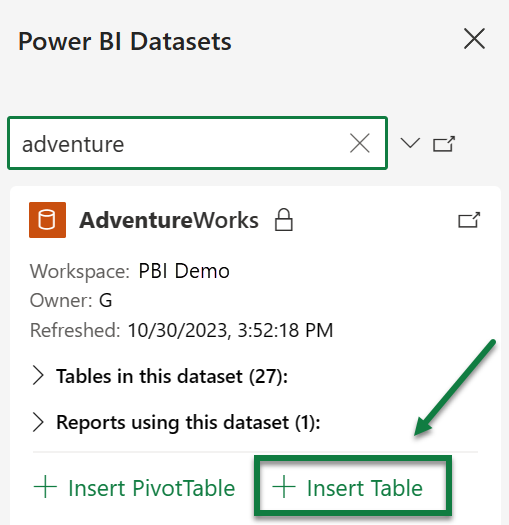 Power BI Connected Tables
Power BI Connected Tables
2. Office Scripts for Office 365 E1 and F3 Licenses
Starting today you can find the Office Scripts feature set in the Automate tab on the Excel ribbon. Office Scripts is an automation platform in Excel that allows users with all levels of programming experience to automate their repetitive workflows. To get started, use the Action Recorder to record the actions you take in Excel. These actions are then translated into a script that you can run at any time. No programming experience required! Read more here >
 Office Scripts
Office Scripts
Check if a specific feature is in your version of Excel
Click here to open in a new browser tab
|
Your feedback helps shape the future of Excel. Please let us know how you like a particular feature and what we can improve upon—“Give a compliment” or “Make a suggestion”.. You can also submit new ideas or vote for other ideas via Microsoft Feedback.
Subscribe to our Excel Blog and the Insiders Blog to get the latest updates. Stay connected with us and other Excel fans around the world – join our Excel Community and follow us on X, formerly Twitter.
Special thanks to our Excel MVPs David Benaim and Bill Jelen for their contribution to this month’s What’s New in Excel article. David publishes weekly YouTube videos and regular LinkedIn posts about the latest innovations in Excel and more. Bill is the founder and host of MrExcel.com and the author of several books about Excel.
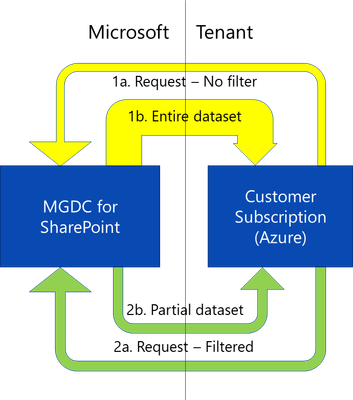
by Contributed | Mar 25, 2024 | Technology
This article is contributed. See the original author and article here.
1. Overview
When gathering SharePoint data through Microsoft Graph Data Connect in a large tenant, you might be pulling many thousands, millions or even billions of objects. If you want to get just a subset of the results, there is a mechanism to filter the results at the source.
A common example is to pull the data just for one site (filtering for the site id) to get started with a large tenant. This way your results will be smaller, cheaper, and easier to handle. You can also use this to get just specific types of sites, like OneDrive or Communication sites.
In this blog, we’ll investigate how you can apply a filter to a dataset in Microsoft Graph Data Connect for SharePoint.
2. What is filtering?
When you request data from the Microsoft Graph Data Connect for SharePoint, you get the full dataset. For instance, if you request the Sites dataset, you get all the sites in the tenant. This is described in the yellow paths below.

If you provide a filter with the request, you can get a partial dataset based on a filter expression. You could, for instance, request all sites with a template id of 21 (that means a OneDrive). This is shown by the green paths above.
In short, filtering delivers a partial dataset based on a filter expression specified in the request. Only objects that meet the criteria are delivered.
The main uses for filtering include:
- Reducing the size of the transfers
- Excluding sensitive data from the results
Filtering is available only in these specific SharePoint datasets:
- SharePoint Sites
- SharePoint Permissions
- SharePoint Group
- SharePoint Files (coming soon)
- SharePoint File Actions (coming soon)
Note: Microsoft Graph Data Connect also offers an option to exclude specific columns from the results, which is another mechanism to protect sensitive data.
3. Datasets and Columns
This filtering feature applies only to the SharePoint datasets listed below. You can filter by Site Id in all SharePoint datasets. You can also filter by Template Id in the Sites, Files and File Actions datasets:
Dataset
|
Site Id column
|
Template Id column
|
Sites
|
Id
|
RootWeb.WebTemplateId
|
Permissions
|
SiteId
|
N/A
|
Group
|
SiteId
|
N/A
|
Files
|
SiteId
|
WebTemplateId
|
File Actions
|
SiteId
|
WebTemplateId
|
For WebTemplateId, refer to this blog post for details on the codes used:
https://barreto.home.blog/2023/04/17/sharepoint-on-mgdc-faq-is-onedrive-included/
If you’re interested in filtering for additional SharePoint dataset columns, please let us know in the comments.
4. Expressions and Operators
Filters are specified using an expression. The expression usually includes a column (as described in the previous section), an operator and a constant.
The main operators supported include:
Type
|
Operator
|
Description
|
Equality
|
eq
|
Equal
|
Equality
|
ne
|
Not Equal
|
Equality
|
in
|
is IN a list
|
Relational
|
lt
|
Less Than
|
Relational
|
gt
|
Greater Than
|
Relational
|
le
|
Less than or Equal
|
Relational
|
ge
|
Greater than or Equal
|
Logical
|
not
|
Not
|
Logical
|
and
|
And
|
Logical
|
or
|
Or
|
Here are a few sample expressions you could use:
Dataset
|
Description
|
Filtering Expression
|
Sites
|
Include only a specific site
|
Id eq ‘a123’
|
Sites
|
Include all sites except a specific site
|
Id ne ‘a123’
|
Sites
|
Include only a specific list of sites
|
Id in (‘a123’, ‘b456’, ‘c789’)
|
Sites
|
Include everything but OneDrive sites
|
RootWeb.WebTemplateId ne 21
|
Permissions
|
Include only a specific site
|
SiteId eq ‘a123’
|
The expression language is patterned after the Microsoft Graph filter query parameter. You can read more about it at https://learn.microsoft.com/en-us/graph/filter-query-parameter.
5. Including the Filter expression in the request
To add a filter to your request, you must specify a DataFilter property in the JSON representation of the request. Start by selecting the Copy Data task you are using and going to the “Source” tab of the Copy Task properties.
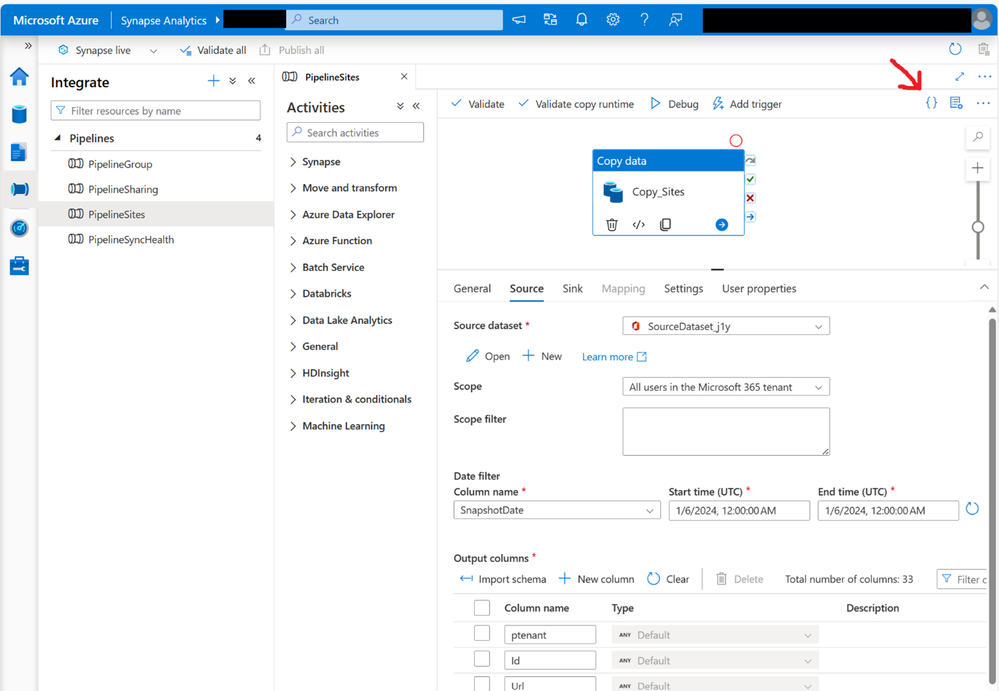
Click on the “{ }” button on the top right (indicated above with a red arrow), which brings up the JSON definition for the request.
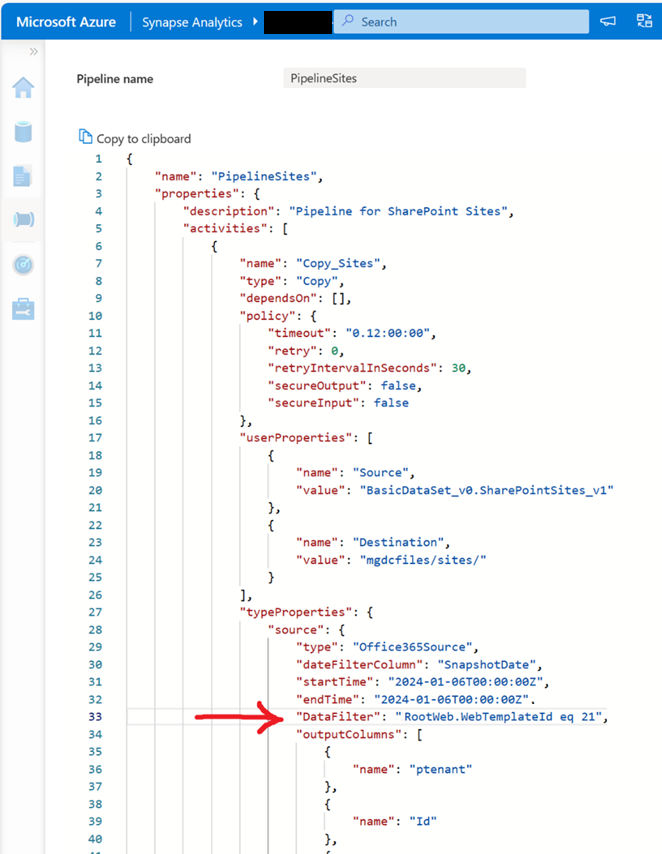
In the JSON definition, find the “source” section under “typeProperties”, where you can find the “dateFilterColumn”, the “startTime” and the “endTime” properties. Add a new “DataFilter” property with the expression you want to apply. Save the changes to the JSON and make sure to publish the pipeline to apply the changes.
In the screenshot above, you see the definition indicated by the red arrow:
acitvity >> typeProperties >> source >> DataFilter >> RootWeb.WebTemplateId eq 21
Be very careful. If you specify the filtering expression in the wrong place in the JSON, the request may fail, or it could just run without filtering anything from the dataset. If you’re running this in a large production tenant, it is recommended to try this first in a small test or dev tenant.
6. More Request Metadata
As a result of this extra property in your request, the results will be filtered, and you will see fewer rows/objects in your output. Another way to see this is looking at the metadata file that is produced with any Microsoft Graph Data Connect run. Look for a folder called “metadata” in the same place you assigned to receive the data (your Azure account container and folder).
In the job metadata file associated with this request, you will see a few additional properties:
- IsFilterApplied – Shows true if the request included a filter expression.
- Filter – The expression passed by in the DataFilter property.
- NumberOfRowsExtracted – Shows the number of rows after the filter was applied.
Here’s a sample of a job metadata file:
{
"CopyActivityId": "00000000-0000-0000-0000-000000000000",
"JobSubmissionTime": "2024-01-10T21:27:18Z",
"JobCompletionTime": "2024-01-10T21:32:44Z",
"RequestStartDate": "2024-01-06T00:00:00Z",
"RequestEndDate": "2024-01-06T00:00:00Z",
"ColumnsRequested":"ptenant, Id, Url, RootWeb, WebCount, StorageQuota, StorageUsed, StorageMetrics, GroupId, GeoLocation, IsInRecycleBin, IsTeamsConnectedSite, IsTeamsChannelSite, TeamsChannelType, IsHubSite, HubSiteId, BlockAccessFromUnmanagedDevices, BlockDownloadOfAllFilesOnUnmanagedDevices, BlockDownloadOfViewableFilesOnUnmanagedDevices, ShareByEmailEnabled, ShareByLinkEnabled, SensitivityLabelInfo, Classification, IBMode, IBSegments, Owner, SecondaryContact, ReadLocked, ReadOnly, CreatedTime, LastSecurityModifiedDate, Operation, SnapshotDate",
"ExtractionMode": "Full",
"IsFilterApplied": true,
"Filter": "RootWeb.WebTemplateId eq 21",
"NumberOfRowsExtracted": 4,
"TableName": "BasicDataSet_v0.SharePointSites_v1",
"ApplicationId": "00000000-0000-0000-0000-000000000000",
"OfficeGeo": "NAM",
"DataFactoryName": "mgdc-synapse"
}
7. Combining Filters with Deltas
It is possible to combine the filtering and the delta features of the SharePoint datasets in Microsoft Graph Data Connect.
When you specify a filtering expression and two different dates, the dataset will be first filtered and then the differences between the two dates will be calculated.
For more details about Delta datasets, see this blog post:
MGDC for SharePoint FAQ: How can I use Delta State Datasets?
8. Filtering Errors
If you pass an expression for filtering and there is a problem with it, Microsoft Graph Data Connect for SharePoint will fail the request and no data will be returned. An error message will be returned so you can understand what happened.
Here are some of the common error conditions:
- Cannot filter and sample at the same time. If you specify both a DataFilter and the Top properties, you will get an error like this:
Operation on target Copy_Sites failed:
ErrorCode=UserErrorOffice365DataLoaderError,
'Type=Microsoft.DataTransfer.Common.Shared.HybridDeliveryException,
Message=Office365 data loading failed to execute.
office365LoadErrorType: PermanentError.
Not Supported: Both DataFilter and AdditionalDataSetProperties with 'top' can not be specified at the same time,
Source=Microsoft.DataTransfer.ClientLibrary,'
- You specified a column name that is not one the columns supported for that dataset. If you specify a non-existent or unsupported column, you will get an error like this:
Operation on target Copy_Sites failed:
ErrorCode=UserErrorOffice365DataLoaderError,
'Type=Microsoft.DataTransfer.Common.Shared.HybridDeliveryException,
Message=Office365 data loading failed to execute.
office365LoadErrorType: PermanentError.
[1]: Invalid schema specified in filters.
Only few columns are supported for filters.
Supported Columns: ['Id', 'RootWeb.WebTemplateId'].
Usage Example: Id eq '00000000-0000-0000-0000-000000000000'
or RootWeb.WebTemplateId eq 21'
,Source=Microsoft.DataTransfer.ClientLibrary,'
- You specified a bad expression. If you specify a malformed expression in your DataFilter expression, you will get an error.
9. Conclusion
I hope this blog post will help you get started with Filtering. For more information about Microsoft Graph Data Connect for SharePoint, please visit the collection of links I keep at Links about SharePoint on Microsoft Graph Data Connect.

by Contributed | Mar 22, 2024 | Technology
This article is contributed. See the original author and article here.
We’re thrilled to announce our first community stand-up – a live stream event tailored for users of Azure API Management and API Center. Join us for an engaging session where we’ll delve into the latest trends in the industry, product updates, and best practices.
Event Details
Date: Wednesday, 27 March 2024
Time: 9 AM PST / 12 PM EST
Format: Live stream on YouTube
What to Expect
- Insights into the API industry: Our product team will share their perspectives on the latest trends in the API industry.
- Azure API Management and API Center updates: Discover the latest features and updates to our services. Learn how these advancements can benefit your organization and enhance your API management practices.
- Guest session – “Designing an active-active global API platform” by Stephane Eyskens: Hear from Stephane how he architected and chaos-tested a resilient API management platform.
- Interactive Q&A session: Do you have a burning question about our products or are you looking to provide feedback? This is your chance! Join our live Q&A session to get answers directly from our team.
- Networking opportunities: Connect with fellow API management practitioners in the chat, exchange ideas, and learn from each other’s experiences.
How to Join
Simply tune into our live stream in the Microsoft Azure Developers channel on YouTube at the scheduled date and time. You can select the “Notify me” button to receive a reminder before the event starts.

Don’t miss out on this exciting opportunity to engage with our product team and fellow API Management and API Center users. Mark your calendars and we’ll see you there!
Export to CSV
Power BI Connected Tables
Office Scripts


Recent Comments